Panel Mounted Governor Control Adjustments
The panel mounted governor control has four potentiometers for making system adjustments. These components are mounted on the control which is located inside the engine instrument panel or generator control panel.
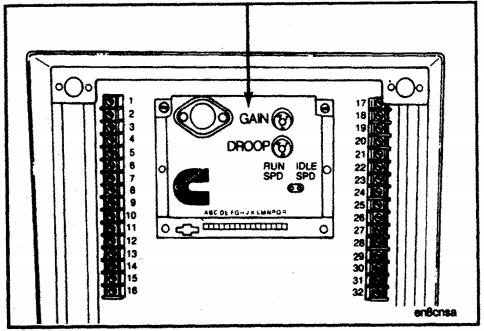
NOTE: When a two bearing generator or a single bearing generator with a flexible drive between the flex discs and shaft (eg. Kohler 4T10 generators. Models 230ROZ, 250 ROZ and 275ROZ) is installed, use a remote mounted control. If the engine is not stable after the gain adjustment is made, install a jumper wire between terminals A and B.
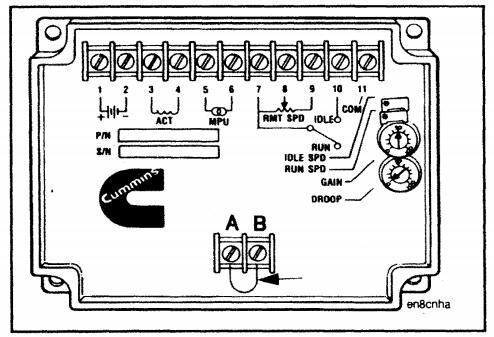
The gain control is a one-turn potentiometer. It is used to adjust the sensitivity of the governor. A clockwise rotation of the potentiometer dial will shorten the response time of the governor to load changes. Refer to the glossary for the gain drescription.
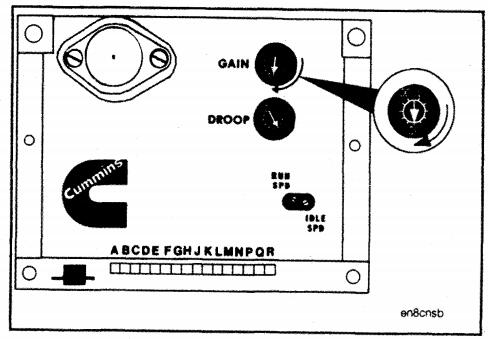
The droop control is a one-turn potentiometer. It is adjustable for zero % (isochronous) to five % speed droop. Counterclockwise rotation will decrease the speed droop.
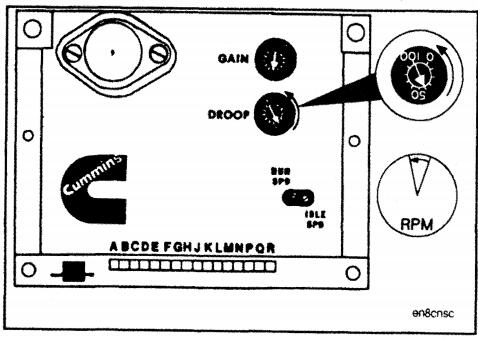
The idle speed controi is a 20-turn potentiometer for adjusting the idle speed. A clockwise rotation will increase the idle speed.
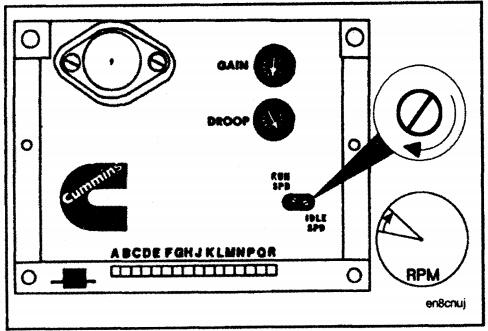
The run speed control is a 20 turn potentiometer for setting the desired no-load governed speed. A clockwise rotation will increase the run speed.
An idle-run switch, located on the engine instrument panel, allows the selection of the idle or run mode.
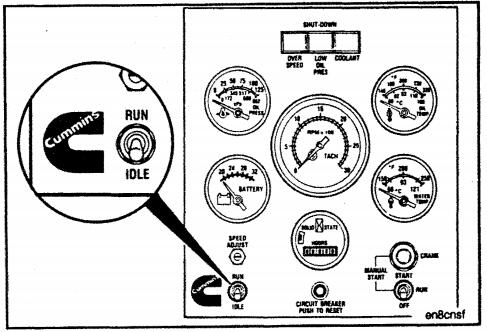
Also located on the engine instrument panel is the Speed Adjust potentiometer which is used for fine speed ajustment after Run Speed, Droop, and Gain have been set.
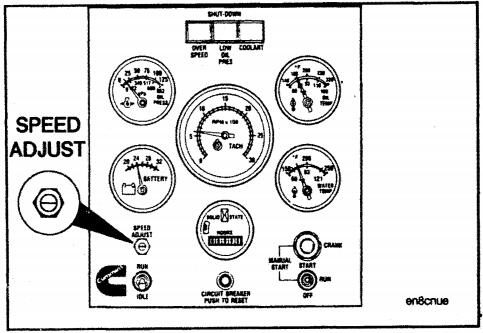
The panel mounted governor control wiring.
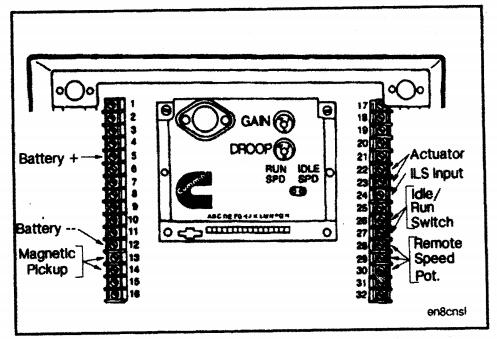
Caution: Measure the voltage on the engine control circuit board terminal strip and not on the control terminal strip. If two terminals on the control terminal strip are shorted, it can damage the control unit.
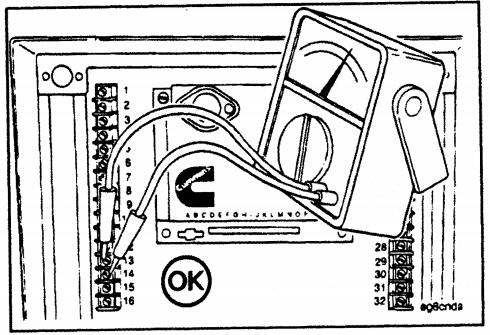
Preliminary Adjustments
The idle speed potentiometer adjustment.
1. Turn the screw counterclockwise 20 turns.
2. Turn the screw clockwise 10 turns.
3. This will set the idle speed potentiometer to its mid position.
The run speed potentiometer adjustment.
This will set the run speed potentiometer to its mid position. (Firs and second points are same to idle speed.)
Turn the gain potentiometer adjustment to midposition or 50.
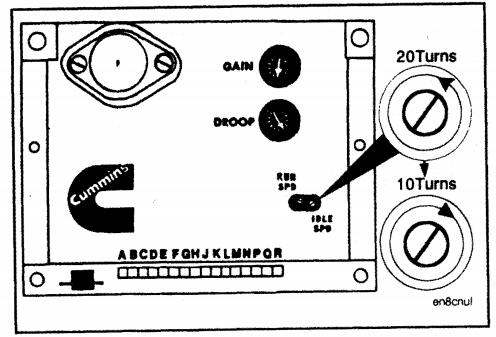
The droop potentiometer adjustment.
1. Turn the potentiometer fully counterclockwise for isochronous operation.
2. Turn the potentiometer to approximately 40 for 3 percent droop.
3. Turn the potentiometer to approximately 80 for 5 percent droop.
Adjust any remote speed potentiometers to the center of their adjustment range.
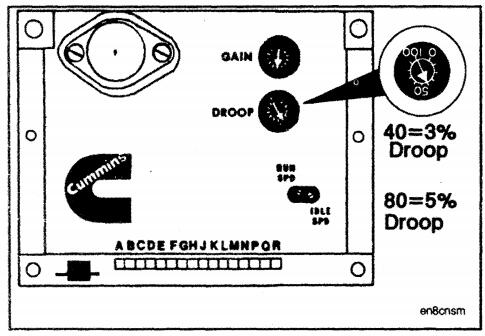
Governed Speed Adjustment
Place the idle-run switch on the engine instrument panel in the idle position.
NOTE: Open the main line circuit breaker while the engine is at idle.
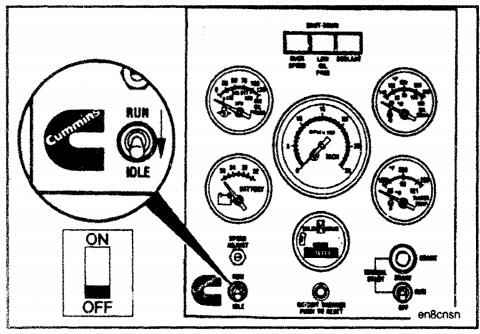
Start the engine. Adjust the idle speed potentiometer the governor control until the engine i:s running at 600 to 650 RPM.
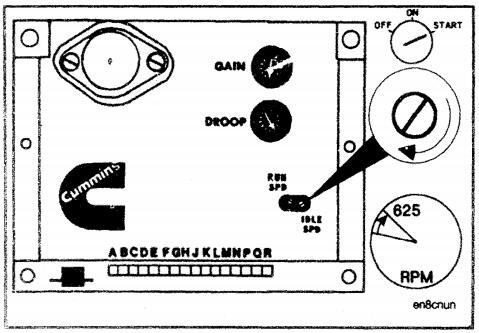
Generators which are to operate at 60 Hz full load, must have the engine no load governed speed adjusted to:
60.0 Hz (1800RPM) for
isochronous operation
61.8 Hz (1854 RPM) for
30/o speed droop
63.0 Hz (1890 RPM) for
5% speed droop
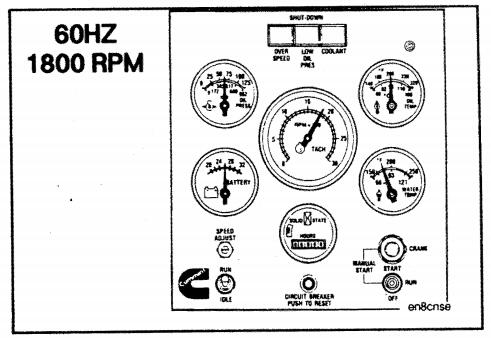
For generators which are to operate at 50 Hz full load, the engine no load governed speed must be adjusted to:
50.0 Hz (1500 RPM) for
isochronous operation
51.5 Hz (1545 RPM) for
3% speed droop
52.5 Hz (1575 RPM) for
5% speed droop
Move the idle run switch to the "Run" position.
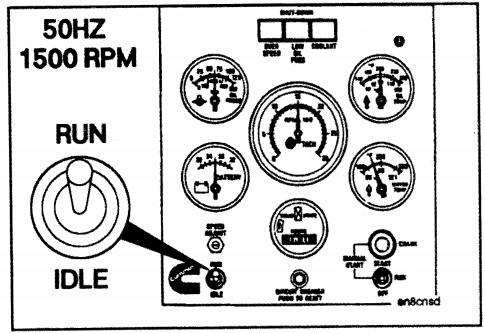
Adjust the run speed potentiometer on the governor control until the no load speed is correct.
NOTE: Close the main line circuit breaker.
Droop Adjustment Isochronous Operation
For isochronous operation, the droop potentiometer must be turned fully counterclockwise and will not require any further adjustment.
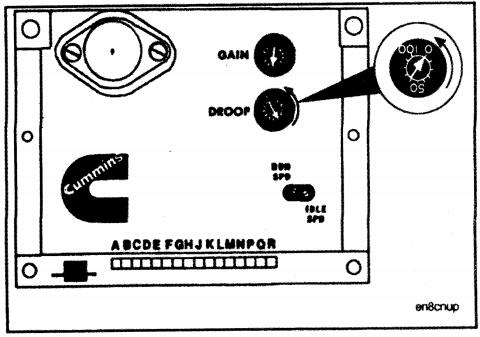
Gain Adjustment
Close the main line circuit breaker and apply approximately 1/4 of the rated load. Make sure the engine speed is constant.
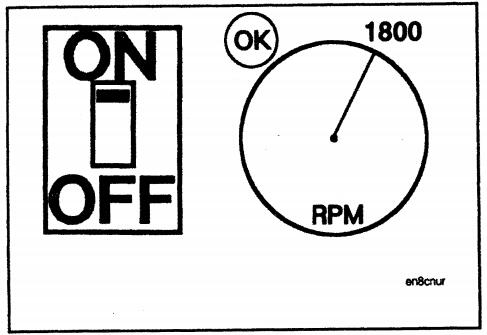
If the engine speed is constant, turn the GAIN potentiometer clockwise slowly until the engine speed is not constant.
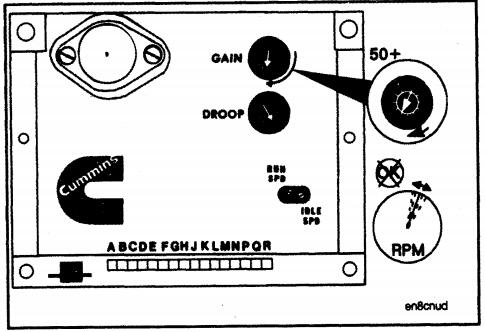
1. Slowly turn the potentiometer counterclockwise until a constant speed is achieved.
2. Turn the potentiometer counterclockwise an additional 1/2 division.
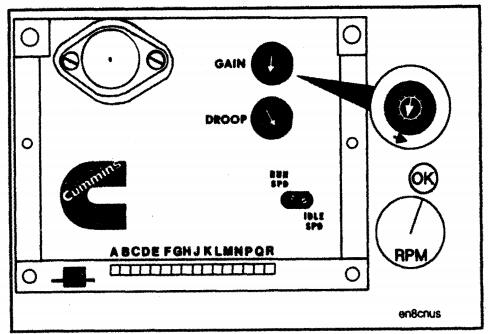
Fine Speed Adjustment
After the gain adjustment is made, the full load governed engine speed may require a minor adjustment to equal the desired speed (i.e. 60 Hz, 1800 RPM or 50 Hz, 1500 RPM). Use the SPEED ADJUST potentiometer on the engine instrument panel for fine speed adjustments of less than ±100 RPM.
System Adjustment Remote Mounted Governor Control
Follow the panel mounted governor control instructions for setting the governed speed, idle, droop and gain on the remote mounted control. The wiring for the remote mounted control is shown.
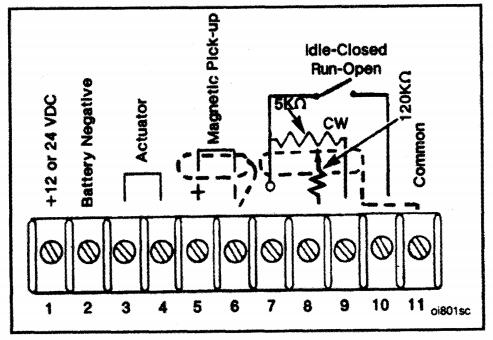
Caution: Do not attach the battery negative to Terminal Number 11. The control circuitry will be damaged.
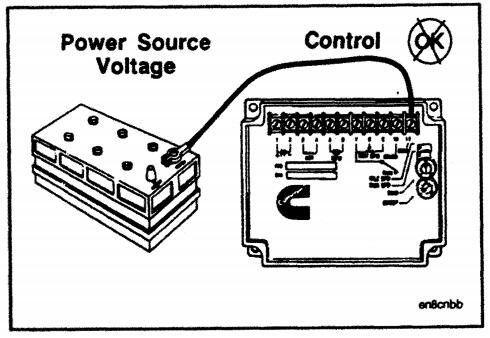
NOTE: When a two bearing generator or a single bearing generator with a flexible drive between the flexible drive between the flex discs and shaft (eg. Kohler 4T10 generators, Models 230ROZ, 250 ROZ and 275 ROZ) is used, install a jumper between terminals A and B. This jumper provides additional stability in the governor control. The oscillation frequency of the coupling between the engine and the generator can cause the governor control to react to this oscillation in addition to a change in engine speed.
Wiring Of Generator Sets
Caution: Measure the voltage of the panel mounted governor control on the printed circuit board terminal strip. Do not measure the voltage on the control terminal strip.
Notes For Auto-Synchronizer
1. The "Gain Range" is changed by adding a jumper between Terminals 6 and 14.
No jumper 6 to 14: Auto-Synchronizer is set for fast responding engines.
With jumper 6 to 14: Auto-Synchronizer is set for slow responding engines.
2.
a. Closing a contact or jumpering 11 to 12 allows the Auto-Synchronizer to perform as a sync check relay only, with circuit breaker contact output but no control on the incoming generator.
b. Closing a contact between 12 to 13 allows the Auto-Synchronizer to perform as a speed matching unit. The speed and phase of the incoming generator are controlled and contact is closed to drive circuit breaker. Once the circuit breaker is closed, the contact between 12 and 13 should be opened.
c. Open contacts or no jumper 11 to 12 or 12 to 13 allows the Auto-Synchronizer to still sense any error but it does not provide any control or contact closures.
3. Phasing of voltage potential to the Auto-Syncrhonizer is necessary to keep each signal in its correct phase relationship. If the generator voltage is not the same as the voltage rating of the Auto-Synchronizer, step-down transformers are required. Correct phasing of the transformer leads is necessary. Step-down transformers require a nominal 10 VA/PHASE for the GEN. input to the Auto-Synchronizer and 7 VA/PHASE for the BUS input to the Auto-Synchronizer.
Notes For lsochronous Load Sharing
4. Systems battery supply. If more than-one engine is started using the same battery supply, use separate battery supply for the DYNA System. Twist power leads as shown. Use shielded leads as shown. Use a single pole, single throw 4 ampere switch.
5. Select current transformers to provide as close as possible 5.0 amps at full-rated load. Current transformers require 12.5 VA/PHASE at 5.0 amps.
6. Observe current transformer polarity markings when connecting.
7. Phasing of voltage potential to the Isochronous Load Sharing Control is necessary to keep each signal on its correct phase relationship. Cummins supplied ILS panels are capable of input voltage ranges from 195 to 260 VAC or 315-535 VAC. If the generator voltage is not the same as the voltage rating of Isochronous Load Sharing Control, step-down transformers are required. Correct phasing of the transformer leads is necessary.
down transformers require a nominal 6 VA/PHASE for the Isochronous Load Sharing Control.
8. Droop/Isochronous switch is not required if units are always operated in the Isochronous mode.
NOTE: We can provide 25KVA to 2750KVA Cummins generator set with canopy soundproof power generation.
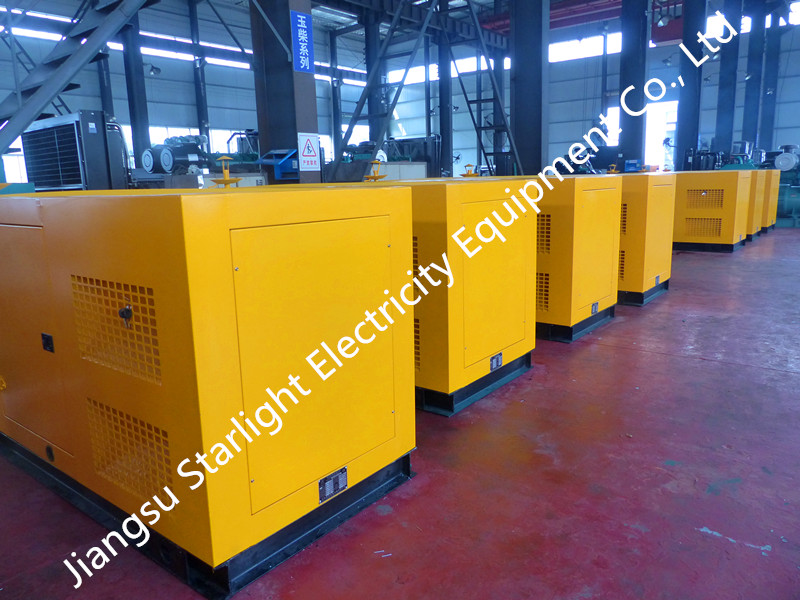
Copyright © Guangxi Dingbo Generator Set Manufacturing Co., Ltd. All Rights Reserved | Sitemap
Update cookies preferences